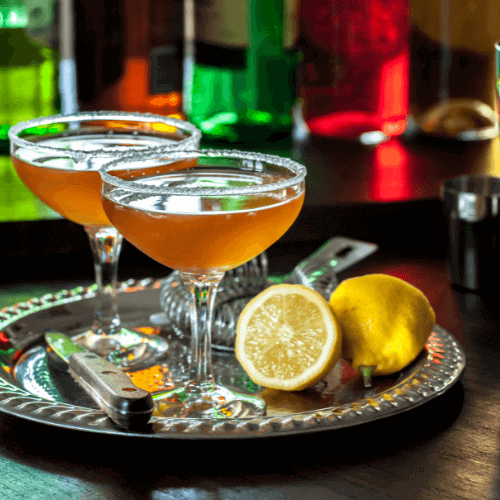Facebook Print Email WhatsApp Table of Contents Ranch Water, the unofficial drink of the American Southwest, has been steadily gaining...

The Sidecar cocktail, with a rich history dating back to the early 20th century, stands as a testament to the enduring appeal of classic cognac drinks. Its origins, likely rooted in the tumultuous era of World War I, have given rise to a cocktail that not only survived the test of time but also became an iconic representation of sophistication and timeless elegance.
The first documented mention of the Sidecar appears in the 1922 edition of “Harry’s ABC of Mixing Cocktails” by Harry MacElhone. Another significant inclusion was found in “Cocktails and How to Mix Them” by Robert Vermeire in 1948, cementing the Sidecar’s place in the canon of classic cocktails. Both books detailed a recipe featuring equal parts cognac, Cointreau, and lemon juice. However, as with many classic cocktails, the Sidecar’s formula underwent modifications over the years.
While the original Sidecar recipe called for equal parts of its three key components, subsequent versions embraced a shift in proportions. A common adaptation, and the one widely recognized today, features two parts cognac, one part Cointreau, and one part fresh lemon juice. This revised formula strikes a balance that allows each ingredient to contribute its unique character without overpowering the others.
The choice of ingredients plays a crucial role in defining the Sidecar’s distinctive flavor profile. Cognac, a high-quality French brandy, forms the backbone of the cocktail, providing depth, warmth, and a nuanced complexity. Cointreau, a premium orange liqueur, adds a sweet and citrusy dimension, while fresh lemon juice contributes a vibrant acidity that balances the richness of the cognac and the sweetness of the liqueur.
Achieving the perfect Sidecar requires precision and attention to detail. The choice of cognac can significantly impact the cocktail, with many opting for VS or VSOP varieties for their balanced flavor profiles. Cointreau’s high-quality orange liqueur is essential, as its bright citrus notes complement the richness of the cognac. Freshly squeezed lemon juice is non-negotiable, as it adds a lively zest that elevates the entire drinking experience.
Beyond its exquisite taste, the Sidecar has become a symbol of sophistication and refinement. The cocktail’s association with the glamorous settings of 1920s and 1930s jazz clubs and speakeasies contributed to its allure. The Sidecar’s popularity soared during the Prohibition era in the United States, as patrons sought clandestine venues where they could enjoy this exquisite drink. Its presence in classic films and literature further solidified its status as a drink synonymous with elegance and style.
The Sidecar’s enduring appeal lies in its ability to bridge the past and the present. Bartenders around the world continue to pay homage to this classic cocktail, showcasing their creativity through variations that add modern twists while preserving the drink’s essential character. The Sidecar’s versatility has allowed it to transcend generations, remaining a favorite among cocktail enthusiasts who appreciate the artistry of a well-crafted drink.
45 ml cognac
22.5 ml Cointreau
22.5 ml fresh lemon juice
Ice
Garnish: sugar rim and orange twist

Rim a coupe glass with sugar, and set aside.
Add the cognac, Cointreau, and fresh lemon juice into a cocktail shaker.
Add ice and shake for 10-12 seconds, until chilled.
Strain into the prepared glass.
Garnish with an orange twist.
Facebook Print Email WhatsApp Table of Contents Ranch Water, the unofficial drink of the American Southwest, has been steadily gaining...
Table of Contents In the world of cocktails, few drinks can boast the rich history and enduring popularity of the...
Table of Contents The Vodka Stinger cocktail, a delightful and contemporary twist on the classic Stinger, has been captivating the...
Facebook Print Email WhatsApp Updated 01/24/24 Table of Contents The Screwdriver, a simple yet iconic cocktail is made with just...
MixDrinkiPedia.com is a participant in the Amazon.com Services LLC Associates Program. As an Amazon Associate we earn from qualifying purchases. Amazon and the Amazon logo are trademarks of Amazon.com, Inc. or its affiliates.